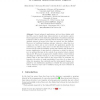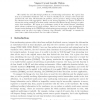RTCSA
1999
IEEE
14 years 3 months ago
1999
IEEE
Data Broadcast in mobile environments has received much attention in recent years and a large number of algorithms proposed. However, existing work in the literature only assume a ...
ECOOP
1999
Springer
14 years 3 months ago
1999
Springer
Several advanced applications, such as those dealing with the Web, need to handle data whose structure is not known a-priori. Such requirement severely limits the applicability of ...
ASYNC
1999
IEEE
14 years 3 months ago
1999
IEEE
The counterflow pipeline architecture [12] consists of two interacting pipelines in which data items flow in opposite directions. Interactions occur between two items when they me...
ACSAC
1999
IEEE
14 years 3 months ago
1999
IEEE
Recently, application-level isolation was introduced as an effective means of containing the damage that a suspicious user could inflict on data. In most cases, only a subset of t...
ICDE
2000
IEEE
14 years 4 months ago
2000
IEEE
We consider the view data lineage problem in a warehousing environment: For a given data item in a materialized warehouse view, we want to identify the set of source data items th...
ICDCS
2000
IEEE
14 years 4 months ago
2000
IEEE
Providing up-to-date input to users’ applications is an important data management problem for a distributed computing environment, where each data storage location and intermedi...
VLDB
2001
ACM
14 years 4 months ago
2001
ACM
Previous research has demonstrated that space can be saved in a MultiMedia DataBase Management System (MMDBMS) by storing some of the data items virtually, meaning they are stored...
DEXAW
2002
IEEE
14 years 4 months ago
2002
IEEE
In this paper, we study the data dissemination problem in time-constrained mobile computing systems (TCMCS) in which maximizing data currency (minimizing staleness) and meeting tr...
NSPW
2003
ACM
14 years 4 months ago
2003
ACM
The ability to analyze and modify binaries is often very useful from a security viewpoint. Security operations one would like to perform on binaries include the ability to extract...
CCGRID
2003
IEEE
14 years 4 months ago
2003
IEEE
Decentralized and unstructured peer-to-peer (P2P) networks such as Gnutella are attractive for Internet-scale information retrieval and search systems because they require neither...




